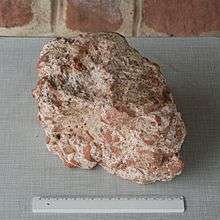Opus signinum
Opus signinum ('cocciopesto' in modern Italian) is a building material used in ancient Rome. It is made of tiles broken up into very small pieces, mixed with mortar, and then beaten down with a rammer.[1] Pliny the Elder in his Natural History describes its manufacture: "Even broken pottery has been utilized; it being found that, beaten to powder, and tempered with lime, it becomes more solid and durable than other substances of a similar nature; forming the cement known as the "Signine" composition, so extensively employed for even making the pavements of houses."[2] Pliny's use of the term "Signine" references "Signia (modern Segni), the name of a town in Latium which was famous for its tiles."[3]

Origins, spread, disuse
The technique began in North Africa, some time before 256 B.C., and spread north from there to Sicily and finally to the Italian peninsula.[4][5] Floors of signinum are found extensively in the Punic towns of North Africa and commonly in the Hellenistic houses on Sicily.[6] While some signinum pavements have been found in Rome, the technique is not common there.[7] Vitruvius describes the process of laying a floor, whether signinum or mosaic.[8] The trend began in the 1st century BC, proliferating in private homes as well as public buildings.[9] By the 2nd century, opus signinum would give way to more patterned styles of pavement.
References
- Signīnum Opus. Harry Thurston Peck, Harpers Dictionary of Classical Antiquities (1898).
- "Pliny, Natural History, book 35, chapter 46". Archived from the original on 2009-10-02. Retrieved 2009-09-17.
- https://en.oxforddictionaries.com/definition/opus_signinum
- The Decorated Pavements of Morgantina II: The Opus Signinum. Author(s): Barbara Tsakirgis. American Journal of Archaeology, Vol. 94, No. 3 (Jul., 1990), pp. 425-443. Archaeological Institute of America. JSTOR 505795
- The houses at Kerkouane on Cap Bon in Tunisia have opus signinum floors. The floors must date before 256 B.C., since the town was destroyed in that year by Regulus. Kerkouane I 79. H. Joyce, "Form, Function and Technique in the Pavements of Delos and Pompeii," AJA 83 (1979) 259.
- For the signinum in the North African houses, see D. Harden, The Phoenicians (London 1962) 133-34; T. Carter, "Western Phoenicians at Lepcis Magna," AJA 69 (1965) 128, pl. 33; M. Fantar, "Pavimenta Punica et signe dit de Tanit dans les habitations de Kerkouane," Studi Magrebini 1 (1966) 57-65; M. Fantar, "Les Pavements puniques," Les Dossiers de l'Archeologie (1978) 6-11; Kerkouane I 502-503; Kerkouane II; S. Lancel, "Les Pavimenta Punica du quartier punique tardif de la colline de Byrsa," Cahiers des etudes anciennes 17 (1985) 157-77. For the signinum floors in Sicilian houses, see for Agrigento: R.P. Jones and E.A. Gardner, JHS 26 (1906) 207-12; E. Gabrici, NSc 1925, 425-37; for Avola: M.T. Currò, BdA 51 (1966) 94; for Gela: D. Adames- teanu, NSc 1956, 346; for Heraclea Minoa: E. De Miro, Kokalos 12 (1966) 227; for Monte Iato: H.P. Isler, AntK 26 (1983) 39; for Solunto: M. deVos, BABESCH 50 (1975) 195- 224; for Syracuse: G. Gentili, NSc 1951, 156-57, NSc 1957, 282, 292; for Tindari: L. Bernabò Brea, BdA 50 (1965) 207.
- M.L. Morricone Matini. Mosaici antichi in Italia: Pavimenti di signino repubblicani di Roma e dintorni (Rome 1971).
- Marcus Vitruvius Pollio: de Architectura, Book VII
- F. Sear. Roman Wall and Vault Mosaics. Heidelberg 1977
- Vassal, V. (2006). Les Pavements d'Opus signinum : technique, décor, fonction architecturale. Oxford.
